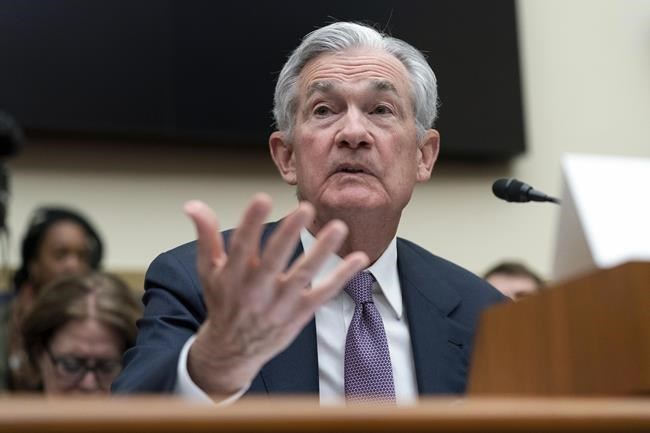WASHINGTON (AP) ÔÇö Federal Reserve Chairman Jerome Powell stressed Wednesday that the central bank's policymakers have yet to decide how large an interest rate hike to impose at its next meeting in two weeks in its drive to defeat high inflation.
ÔÇ£If ÔÇö and I stress that no decision has been made on this ÔÇö if the totality of the data were to indicate that faster tightening is warranted, we would be prepared to increase the pace of rate hikes,ÔÇØ Powell said on his second day of semi-annual testimony to Congress.
The Fed chair had made to a Senate panel but had not included the caveat that ÔÇ£no decision has been made.ÔÇØ Some economists and Wall Street traders had interpreted those remarks as a signal that the Fed would raise its benchmark rate by a substantial half-point at its March 21-22 meeting.
As a result, stock prices tumbled Tuesday, and some bond yields rose as markets anticipated a faster pace of rate hikes.
When the Fed raises its key short-term rate, it typically leads to more expensive mortgages, auto loans, credit card lending and business loans. Higher rates can discourage consumers from spending and thereby cool the economy and inflation. But they also raise the risk that the economy will fall into a recession.
Powell's more nuanced remarks Wednesday appeared to be an effort to quell any assumption that the Fed has already decided to raise rates more aggressively based on a recent string of data that .
At its meeting in early February, the Fed slowed its pace of hikes, boosting its key rate by just a quarter-point, after and three-quarters of a point four times before that. Powell's comments Tuesday appeared to imply that the Fed would return to larger rates hikes at its next meeting March 21-22.
But under questioning Wednesday from Rep. Patrick McHenry, the Republican chairman of the House Financial Services Committee, Powell said the Fed would closely scrutinize data on hiring, retail sales and inflation that will be released next week before settling on its next interest rate moves.
ÔÇ£WeÔÇÖre not on a preset path, and we will be guided by the incoming data,ÔÇØ Powell said. ÔÇ£We have not made any decision about the March meeting.ÔÇØ
Krishna Guha, an analyst at Evercore ISI, an investment bank, said he inferred from Powell's remarks Wednesday that either a half-point or a quarter-point hike is possible when the Fed next meets in two weeks. But Guha suggested that after JanuaryÔÇÖs strong economic data, the economy would likely have to show signs that it was cooling sharply for the Fed to hike by only a quarter-point.
Though Powell left the door open Wednesday to only a quarter-point hike this month, he reiterated his comments from Tuesday that signaled that the Fed will ultimately raise its key rate higher than it had forecast in December.
ÔÇ£The data weÔÇÖve seen so far this year," he said Wednesday, ÔÇ£suggests that the ultimate level of rates will need to be higher.ÔÇØ
Economists at Goldman Sachs said Tuesday they now expect the central bank to raise its benchmark short-term rate to roughly 5.6%, up from its current 4.6%. That would be above the 5.1% level that the Fed's policymakers had penciled in at their meeting in December.
One of the government economic reports Powell had mentioned as key to the Fed's outlook was released Wednesday, and it reflected a still-strong labor market that could keep the economy running hot: The Labor Department's report on job openings showed that businesses are still seeking to fill millions of positions.
Though the number of job vacancies fell in January, the figure remained at a historically very high level. The Fed watches this data because many companies sharply raise wages to try to attract or retain workers, and then often pass those higher labor costs on to their customers in the form of higher prices. That cycle tends to fuel higher inflation.
Guha said he thought the new data on job vacancies weighed slightly in favor of a half-point increase at the Fed's next meeting.
In his testimony Wednesday, Powell repeated his warnings that Congress should raise the nation's borrowing limit, or debt ceiling, to avoid any chance that the government would default on its debts for the first time.
Since , the Treasury Department has used accounting maneuvers to keep paying the government's bills. But current estimates suggest that those maneuvers will no longer work by sometime this summer. At that point, the government could no longer borrow to make bond payments or issue Social Security or other benefit checks.
Congressional Republicans are demanding steep spending cuts as a condition for voting to lift the debt ceiling; President Joe Biden has said he won't negotiate on the issue. He notes that Republicans joined Democrats in raising the debt ceiling three times ÔÇö without conditions ÔÇö under President Donald Trump.
ÔÇ£Congress raising the debt ceiling is really the only alternative,ÔÇØ Powell said. ÔÇ£No one should be thinking that we have the tools to protect the economy from all potential effectsÔÇØ of failing to do so.
Christopher Rugaber, The Associated Press



